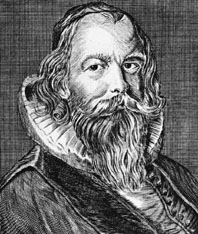

 | Page 1331 |  |
and medicine before becoming personal physician to Christian IV, king of Denmark. Worm was a contemporary and colleague of the Swedish antiquarian johan bure and had similar interests in rune stones and collecting archaeological and ethnographic artifacts and other antiquities. He corresponded widely with other antiquarians across Europe, learned Old Norse from Icelanders in order to translate runes, and speculated about tumuli with the English antiquarian Sir Henry Spelman. In 1626, he organized a royal circular to be sent to all of the clergy throughout Denmark to submit reports on any rune stones, burial sites, or other historic remains and then sent draftsmen out to record them. The resulting mass of information was the basis of Worm’s six volumes on Danish monuments published in 1644, the antiquarian record of Denmark with illustrations and maps.

Ole Worm
(Ann Ronan Picture Library)
He also established the Museum Wormianum, a kind of extended cabinet of curiosities, to display his collections and the donations of others. This collection was passed on to King Frederick III after Worm’s death. It was installed in the old castle in Copenhagen and then moved in 1680 to a new building in Christiansborg, where it was opened to the public as the Kunstkammer (Royal Collection), which in time became a part of the Danish National Museum of Antiquities.
References
Schapp, A. 1996. The Discovery of the Past. London: British Museum Press.
(1914–1994)
One of the first female archaeologists in North America, Hannah Marie Wormington made significant contributions to Paleo-Indian archaeology. She was born and attended schools in Denver, Colorado, and she would live and work in this city as an adult for over thirty years. Wormington began studying medicine and zoology at the University of Denver, but under the influence of French archaeologist E. B. Renaud, she became interested in the prehistory of the Americas and participated in fieldwork in Colorado and New Mexico.
In 1935 she traveled to Europe, where she met and was greatly impressed by the renowned English archaeologist dorothy garrod. Wormington, whose mother was of French origin, studied in Paris and joined Paleolithic excavations in the Dordogne. She returned to work at the Colorado Museum of Natural History (later the Denver Museum of Nature and Science), where she began studying Paleo-Indian material in the collection. This typological work was the subject of her first paper, presented in 1937 at the International Symposium of Early Man in Philadelphia, Pennsylvania. It was so well received that it established her as a major contributor to the current debate around and study of Paleo-Indians.
Her later publication, Ancient Man in North America (1939); was based on this paper and was the first summary and synthesis by an archaeologist of the evidence for Pleistocene and early-Holocene occupations in North America. The book went through four editions (the last in 1957) and is still regarded as a classic in Paleo-Indian studies.
In 1937 Wormington began postgraduate study at Radcliffe College, where she was the first doctoral student in anthropology. She also attended classes at Harvard University and was
 |  |